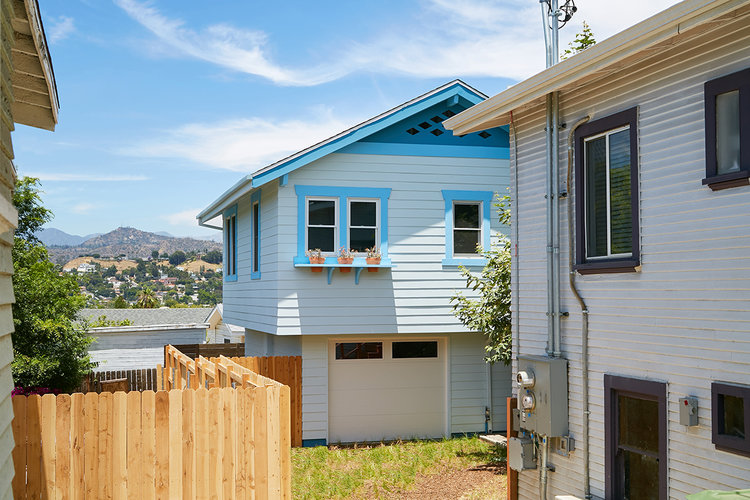
ADU Reform Basics
Best practices for allowing second units in single-family zones.
Photo credit: LA Más ADU Pilot Project
What are ADUs?
Accessory Dwelling Units (ADUs) are secondary dwelling units added to single family homes. They are sometimes called “granny flats,” “in-law suites,” or guest houses.
What are the different types of ADUs?
ADUs can take multiple forms:
- Detached ADUs are what they sound like: freestanding structures detached from the main house.
- Attached ADUs are built as an extension of the existing structure, sometimes replacing an existing parking garage.
- Junior ADUs (JADUs) are ADUs created entirely inside a home’s existing space.
Why legalize ADUs?
The overwhelming majority of America’s urban residential land is exclusively zoned for single family housing. Single-family homes, which were designed for two-parent households with children, have become an increasingly poor fit for many Americans’ family structures as households have gotten smaller, more people have chosen to live alone, seniors have aged in place, and more people have come to live in intergenerational households.
Allowing ADU construction gives people the opportunity to adapt their homes to meet their individual needs as they change over time, which is particularly useful for seniors. ADUs also add incremental density to single-family-only neighborhoods without provoking much political backlash. This means more relatively low-cost housing in desirable areas.
How can cities and states make it easier for homeowners to build ADUs?
Since 2016, California’s state legislature has passed a suite of reforms that have standardized and streamlined ADU development on every single-family-only lot in the state. Other states, and some cities, have followed California’s lead: Oregon has allowed ADUs statewide since 2017 and St. Paul has allowed them citywide since 2018.
While the specific details are highly technical, these reforms have made it fairly easy for many homeowners to add one or two ADUs to their property if they want to.
Give me the technical details.
Okay, you asked for it. Generally, this is what cities and states can do to encourage ADU development:
Enact comprehensive zoning reform. In California, the state has overridden essentially all local zoning standards to allow one-story, 800-square-foot ADUs to be built on any lot with an existing or proposed single-family residence.
Set statewide standards. California’s statewide standards for unit size, setbacks, and height have greatly simplified ADU development by eliminating the need for builders to parse complex, city-specific zoning standards. This has made it much easier for ADU professionals to work with homeowners in multiple jurisdictions, which has fostered the creation of a vibrant ADU development industry.
Make ADUs by-right and issue permits quickly. Broadly, there are two different kinds of permitting processes: by-right and discretionary. Discretionary permits require a hearing and approval from a local planning commission, which can impose various conditions on a project that might go beyond what the zoning requires. This is in contrast to by-right permitting, in which any project that follows the zoning rules gets a permit straight from the planning department.
Making ADUs by-right and imposing strict deadlines on processing times gave homeowners certainty that they would actually be able to build their projects. This, in turn, gave them the confidence to invest in pre-development costs, which can run to several thousand dollars.
Reform or eliminate parking requirements. Parking requirements — such as zoning rules that require homeowners to add off-street parking for every new housing unit or replace spaces lost to a garage conversion — make it impossible to build an ADU on many properties. Removing parking requirements and allowing additional flexibility, such as by allowing “tandem” parking (one car parked behind another in a driveway or garage), makes many more projects feasible.
Institute fee reforms. New development is often subject to extremely high development and utility connection fees, which can run to tens of thousands of dollars per unit. California passed reforms capping these fees and allowing ADUs to use the same utility connection as the existing “main” house.
Eliminate use restrictions. California affirmatively allows ADUs to be rented to tenants, though cities and homeowner associations may ban using them for short-term rentals like AirBnBs. The state also forbids local governments from imposing owner-occupancy restrictions. These rules ensure that landlords can add additional units to their rental properties.
Educate the public. A number of local governments and nonprofits have released ADU guidebooks for homeowners that outline the process for adding a second or third unit to their properties. These materials, and workshops put on by local housing advocates, have made ADU development more approachable for homeowners.
Expand access to finance. Securing financing is a major obstacle to ADU development, particularly for homeowners who do not have significant equity in their homes or cash on hand. Grant or loan programs, often paired with technical assistance, can help bridge the gap.
Where can I go to learn more?
Here are some resources if you’d like to know more:
- San Diego’s Success in Spurring Missing Middle Housing
- The Forgotten Green Housing Option
- The Magic of the Granny Flat
- All About Accessory Dwelling Units
This primer was prepared by Max Dubler.